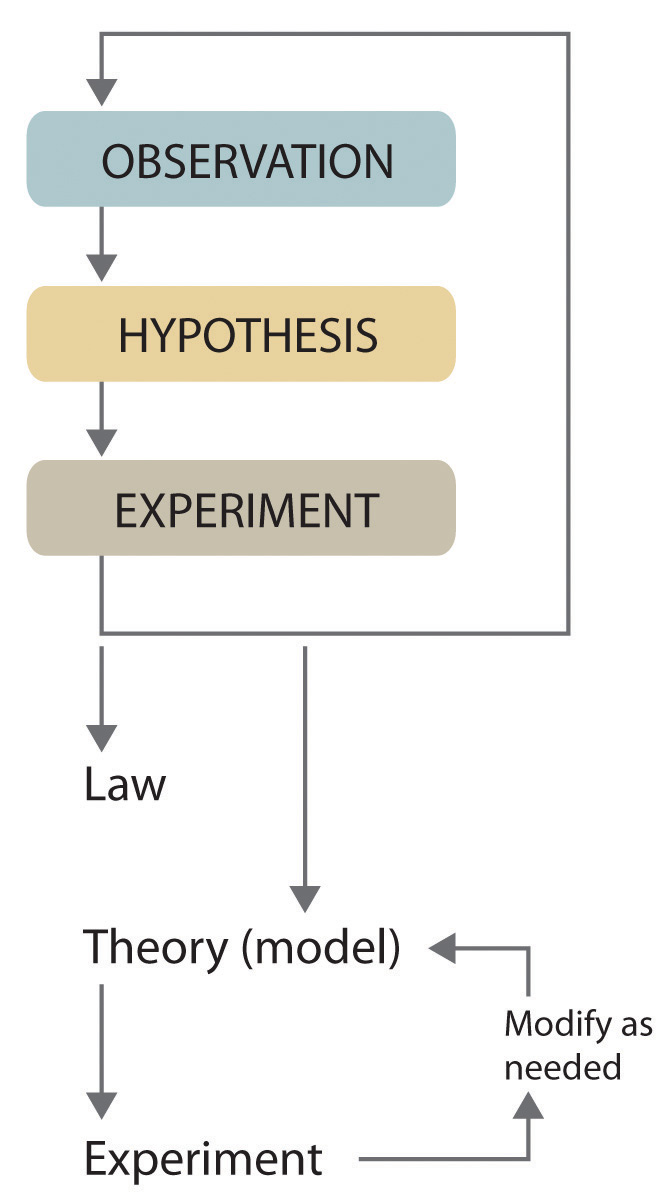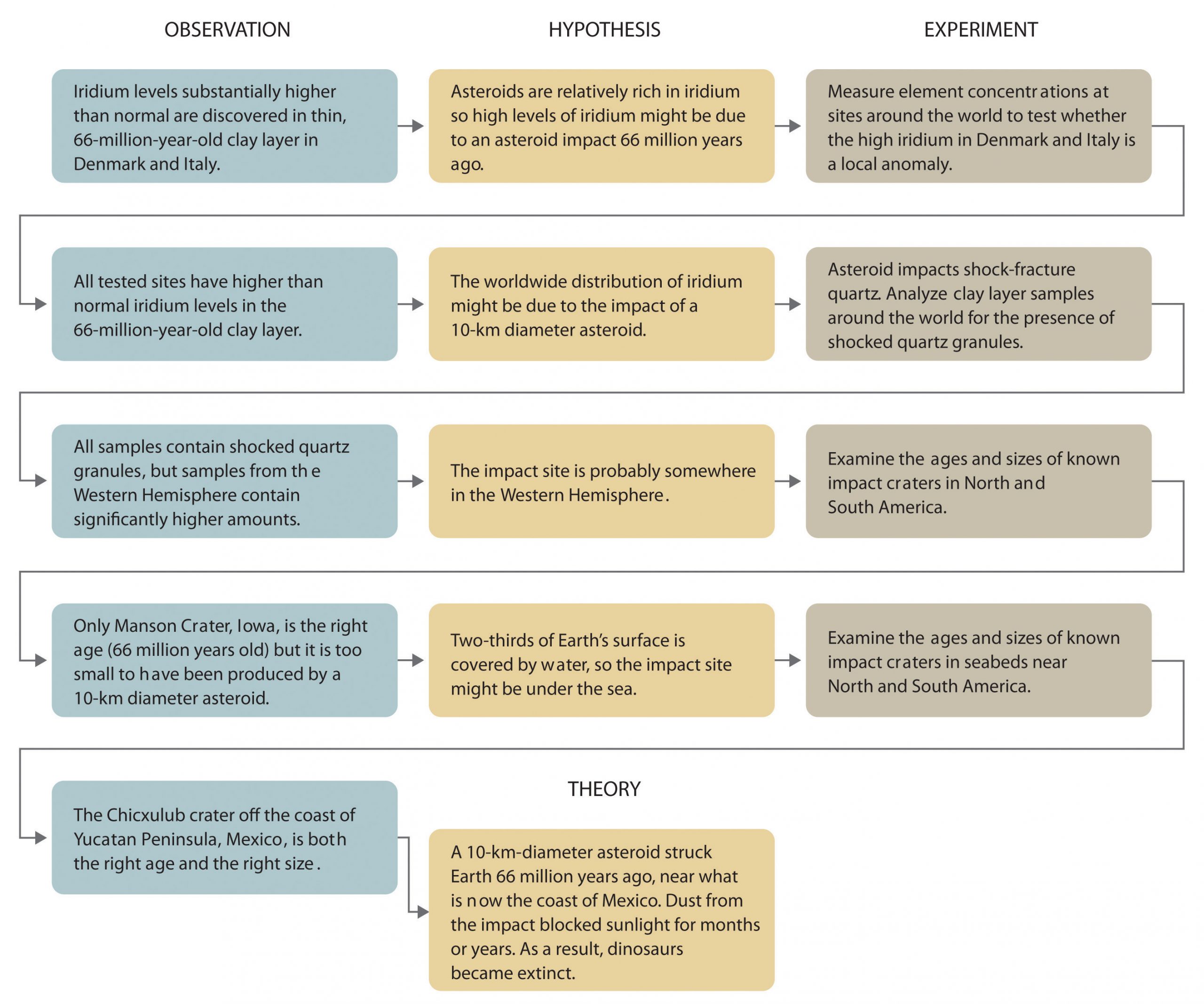3 The Scientific Method
Saylor Academy
LEARNING OBJECTIVES
To identify the components of the scientific method.
Scientists search for answers to questions and solutions to problems by using a procedure called the scientific method. This procedure consists of making observations, formulating hypotheses, and designing experiments, which in turn lead to additional observations, hypotheses, and experiments in repeated cycles (Figure 1.4 “The Scientific Method”).
Figure 1.4 The Scientific Method

Observations can be qualitative or quantitative. Qualitative observations describe properties or occurrences in ways that do not rely on numbers. Examples of qualitative observations include the following: the outside air temperature is cooler during the winter season, table salt is a crystalline solid, sulfur crystals are yellow, and dissolving a penny in dilute nitric acid forms a blue solution and a brown gas. Quantitative observations are measurements, which by definition consist of both a number and unit. Examples of quantitative observations include the following: the melting point of crystalline sulfur is 115.21 degrees Celsius, and 35.9 grams of table salt—whose chemical name is sodium chloride—dissolve in 100 grams of water at 20 degrees Celsius. For the question of the dinosaurs’ extinction, the initial observation was quantitative: iridium concentrations in sediments dating to 66 million years ago were 20–160 times higher than normal.
After deciding to learn more about an observation or a set of observations, scientists generally begin an investigation by forming a hypothesis, a tentative explanation for the observation(s). The hypothesis may not be correct, but it puts the scientist’s understanding of the system being studied into a form that can be tested. For example, the observation that we experience alternating periods of light and darkness corresponding to observed movements of the sun, moon, clouds, and shadows is consistent with either of two hypotheses: (1) Earth rotates on its axis every 24 hours, alternately exposing one side to the sun, or (2) the sun revolves around Earth every 24 hours. Suitable experiments can be designed to choose between these two alternatives. For the disappearance of the dinosaurs, the hypothesis was that the impact of a large extraterrestrial object caused their extinction. Unfortunately (or perhaps fortunately), this hypothesis does not lend itself to direct testing by any obvious experiment, but scientists can collect additional data that either support or refute it.
After a hypothesis has been formed, scientists conduct experiments to test its validity. Experiments are systematic observations or measurements, preferably made under controlled conditions—that is, under conditions in which a single variable changes. For example, in our extinction scenario, iridium concentrations were measured worldwide and compared. A properly designed and executed experiment enables a scientist to determine whether the original hypothesis is valid. Experiments often demonstrate that the hypothesis is incorrect or that it must be modified. More experimental data are then collected and analyzed, at which point a scientist may begin to think that the results are sufficiently reproducible (i.e., dependable) to merit being summarized in a law, a verbal or mathematical description of a phenomenon that allows for general predictions. A law simply says what happens; it does not address the question of why. One example of a law, the law of definite proportions, which was discovered by the French scientist Joseph Proust (1754–1826), states that a chemical substance always contains the same proportions of elements by mass. Thus sodium chloride (table salt) always contains the same proportion by mass of sodium to chlorine, in this case 39.34% sodium and 60.66% chlorine by mass, and sucrose (table sugar) is always 42.11% carbon, 6.48% hydrogen, and 51.41% oxygen by mass. You will learn later that some solid compounds do not strictly obey the law of definite proportions. The law of definite proportions should seem obvious—we would expect the composition of sodium chloride to be consistent—but the head of the US Patent Office did not accept it as a fact until the early 20th century.
Whereas a law states only what happens, a theory attempts to explain why nature behaves as it does. Laws are unlikely to change greatly over time unless a major experimental error is discovered. In contrast, a theory, by definition, is incomplete and imperfect, evolving with time to explain new facts as they are discovered. The theory developed to explain the extinction of the dinosaurs, for example, is that Earth occasionally encounters small- to medium-sized asteroids, and these encounters may have unfortunate implications for the continued existence of most species. This theory is by no means proven, but it is consistent with the bulk of evidence amassed to date. Figure 1.5 “A Summary of How the Scientific Method Was Used in Developing the Asteroid Impact Theory to Explain the Disappearance of the Dinosaurs from Earth” summarizes the application of the scientific method in this case.
Figure 1.5 A Summary of How the Scientific Method Was Used in Developing the Asteroid Impact Theory to Explain the Disappearance of the Dinosaurs from Earth

EXAMPLE PROBLEMS
Example 1
Classify each statement as a law, a theory, an experiment, a hypothesis, a qualitative observation, or a quantitative observation.
- Ice always floats on liquid water.
- Birds evolved from dinosaurs.
- Hot air is less dense than cold air, probably because the components of hot air are moving more rapidly.
- When 10 g of ice were added to 100 mL of water at 25°C, the temperature of the water decreased to 15.5°C after the ice melted.
- The ingredients of Ivory soap were analyzed to see whether it really is 99.44% pure, as advertised.
Asked for: statement classification
Strategy: Refer to the definitions in this section to determine which category best describes each statement.
Solution:
- This is a general statement of a relationship between the properties of liquid and solid water, so it is a law.
- This is a possible explanation for the origin of birds, so it is a hypothesis.
- This is a statement that tries to explain the relationship between the temperature and the density of air based on fundamental principles, so it is a theory.
- The temperature is measured before and after a change is made in a system, so these are quantitative observations.
- This is an analysis designed to test a hypothesis (in this case, the manufacturer’s claim of purity), so it is an experiment.
Exercise 2
Classify each statement as a law, a theory, an experiment, a hypothesis, a qualitative observation, or a quantitative observation.
- Measured amounts of acid were added to a Rolaids tablet to see whether it really “consumes 47 times its weight in excess stomach acid.”
- Heat always flows from hot objects to cooler ones, not in the opposite direction.
- The universe was formed by a massive explosion that propelled matter into a vacuum.
- Michael Jordan is the greatest pure shooter ever to play professional basketball.
- Limestone is relatively insoluble in water but dissolves readily in dilute acid with the evolution of a gas.
- Gas mixtures that contain more than 4% hydrogen in air are potentially explosive.
Solution:
- experiment
- law
- theory
- hypothesis
- qualitative observation
- quantitative observation
Because scientists can enter the cycle shown in Figure 1.4 “The Scientific Method” at any point, the actual application of the scientific method to different topics can take many different forms. For example, a scientist may start with a hypothesis formed by reading about work done by others in the field, rather than by making direct observations.
It is important to remember that scientists have a tendency to formulate hypotheses in familiar terms simply because it is difficult to propose something that has never been encountered or imagined before. As a result, scientists sometimes discount or overlook unexpected findings that disagree with the basic assumptions behind the hypothesis or theory being tested. Fortunately, truly important findings are immediately subject to independent verification by scientists in other laboratories, so science is a self-correcting discipline. When the Alvarezes originally suggested that an extraterrestrial impact caused the extinction of the dinosaurs, the response was almost universal skepticism and scorn. In only 20 years, however, the persuasive nature of the evidence overcame the skepticism of many scientists, and their initial hypothesis has now evolved into a theory that has revolutionized paleontology and geology.
Summary
Chemists expand their knowledge by making observations, carrying out experiments, and testing hypotheses to develop laws to summarize their results and theories to explain them. In doing so, they are using the scientific method.
KEY TAKEAWAYS
Chemists expand their knowledge with the scientific method.
CONCEPTUAL PROBLEMS
- What are the three components of the scientific method? Is it necessary for an individual to conduct experiments to follow the scientific method?
- Identify each statement as a theory or a law and explain your reasoning.
- The ratio of elements in a pure substance is constant.
- An object appears black because it absorbs all the visible light that strikes it.
- Energy is neither created nor destroyed.
- Metals conduct electricity because their electrons are not tightly bound to a particular nucleus and are therefore free to migrate.
- Identify each statement as a theory or a law and explain your reasoning.
- A pure chemical substance contains the same proportion of elements by mass.
- The universe is expanding.
- Oppositely charged particles attract each other.
- Life exists on other planets.
- Classify each statement as a qualitative observation or a quantitative observation.
- Mercury and bromine are the only elements that are liquids at room temperature.
- An element is both malleable and ductile.
- The density of iron is 7.87 g/cm3.
- Lead absorbs sound very effectively.
- A meteorite contains 20% nickel by mass.
- Classify each statement as a quantitative observation or a qualitative observation.
- Nickel deficiency in rats is associated with retarded growth.
- Boron is a good conductor of electricity at high temperatures.
- There are 1.4–2.3 g of zinc in an average 70 kg adult.
- Certain osmium compounds found in air in concentrations as low as 10.7 µg/m3 can cause lung cancer.
Answers
3.
- law
- theory
- law
- theory
5.
- qualitative
- qualitative
- quantitative
- quantitative
a way of discovering knowledge based on making falsifiable predictions (hypotheses), testing them, and developing theories based on collected data
an educated guess that usually is found in an “if…then…” format
(also, law of constant composition) all samples of a pure compound contain the same elements in the same proportions by mass

